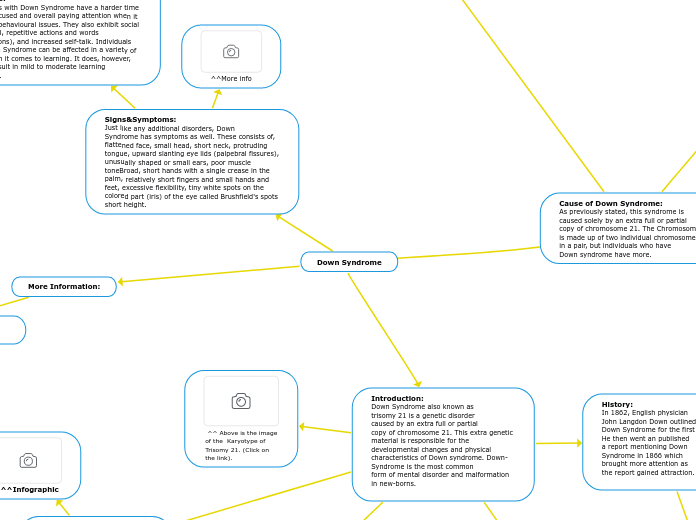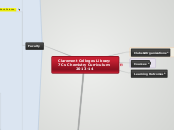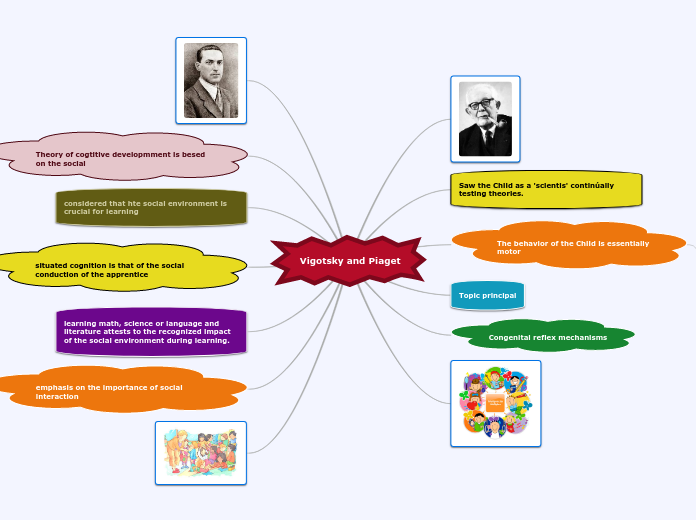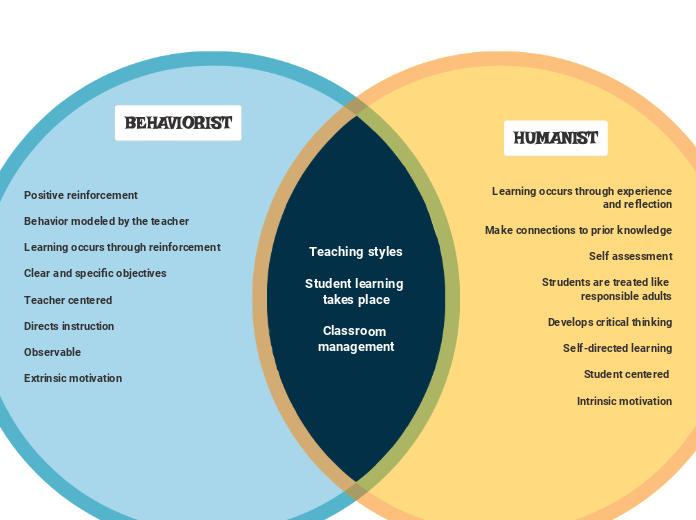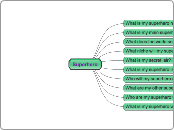Down Syndrome
More Information:
https://www.youtube.com/watch?v=DqQ806YzEoU
Signs&Symptoms:
Just like any additional disorders, Down
Syndrome has symptoms as well. These consists of, flattened face, small head, short neck, protruding tongue, upward slanting eye lids (palpebral fissures), unusually shaped or small ears, poor muscle toneBroad, short hands with a single crease in the palm, relatively short fingers and small hands and feet, excessive flexibility, tiny white spots on the colored part (iris) of the eye called Brushfield's spots short height.
^^More info
Behavioural & Learning Difficulties/
problems:
Individuals with Down Syndrome have a harder time staying focused and overall paying attention when it comes to behavioural issues. They also exhibit social withdrawal, repetitive actions and words (compulsions), and increased self-talk. Individuals with Down Syndrome can be affected in a variety of ways when it comes to learning. It does, however, usually result in mild to moderate learning difficulties.
Diagnosis:
The majority of the time (95%), the diagnosis of Down Syndrome occurs during pregnancy. There are screening tests available, however, they will not tell you for sure whether or not your child has Down Syndrome. Some of the tests that can be taken
during pregnancy are as follows: Blood-Tests, Nuchal translucency test, Chorionic villus sampling & Amniocentesis. After birth, doctors will often check
appearance and as well as do a chromosomal karyotype to confirm diagnosis.
Cause of Down Syndrome:
As previously stated, this syndrome is
caused solely by an extra full or partial
copy of chromosome 21. The Chromosome
is made up of two individual chromosomes
in a pair, but individuals who have
Down syndrome have more.
Translocation
Causes:
As for Translocation, it can occur by two different ways. One, by chance. Two, can be
caused by extra genes in the egg or sperm of one of the parents.
https://www.youtube.com/watch?v=wJfe0-5uHZo
Differs between others:
In Translocation Down Syndrome an extra copy of chromosome 21 is attached to another chromosome - most often it's attached to chromosome 14. This will copy and result in all cells of the body.
Mosaicism
https://www.youtube.com/watch?v=d93KUa-quS4
Image
Differs between others:
Mosaicism, unlike the other types of Down Syndrome, occurs when an extra copy of Chromosome 21 is found in SOME cells. This means that SOME cells have an extra copy of Chromosome 21, while others do not.
Causes:
This type of Down Syndrome occurs during the process of cell division. This is the stage at which some cells receive an extra copy while others do not. There is absolutely no way to determine which or how many cells contain the copy.
Trisomy 21 (Nondisjunction)
Causes:
The cells did not divide properly in Trisomy 21 and other types of Down Syndrome, resulting in an extra copy. Sometimes chromosome 21 "sticks" together in an egg, resulting in three copies when a sperm meets the egg.
https://www.youtube.com/watch?v=ze_6VWwLtOE
Differs between others:
The most common type of DOwn Syndrome is trisomy 21, which occurs when an extra copy of Chromosome 21 is found in ALL cells of the body.
Preventation:
There's not much you as an individual can do
to prevent having a child with ANY type of Down Syndrome. Down Syndrome is by chance.
Treatments:
Unfortunately, no treatments exist to cure ANY Down Syndrome. Early intervention programs, on the other hand, can help with skill development. Therapy such as speech, physical, occupational, and/or educational therapy may also be beneficial. With the right support and treatment, many people with Down syndrome live happy, productive lives.
Risks:
Pregnant mothers over the age of 35 are at an increased risk of having a child with Down Syndrome. Those who already have a Down Syndrome child are at a higher risk. This is true for all three types of Down Syndrome.
Introduction:
Down Syndrome also known as
trisomy 21 is a genetic disorder
caused by an extra full or partial
copy of chromosome 21. This extra genetic
material is responsible for the
developmental changes and physical
characteristics of Down syndrome. Down-
Syndrome is the most common
form of mental disorder and malformation
in new-borns.
Statistics:
In Canada, one out of every
781 babies are born with
Down syndrome. Down
syndrome affects
approximately 45,000 Canadians.,
^^Infographic
Support:
Fortunately across Ontario and in Canada, there are many support agencies/groups and funding
available to those who have Down Syndrome and parents of children with
Down Syndrome.
Down Syndrome Association of
York Region:
This is a charitable organization that
aim to promote support and advocacy for
people who have Down Syndrome. They
have a LOT of services and support for families such as parent get-togethers, providing a New Parent Package (for new parents of a Down Syndrome child), representing Down Syndrome, providing networking opportunities for families, friends, caregivers, and educators who are living and working with people with Down syndrome and so much more.
https://dsayr.ca/about-us/
Down Syndrome Association of Toronto:
This is a non-profit organization that supports & empowers individuals with Down Syndrome and their families in the GTA. They host events to raise awareness regarding Down Syndrome and for individuals with Down Syndrome and their families. They also provide resources.
https://dsat.ca/about-dsat/
Down Syndrome
Association of Ontario:
This is a non-profit organization
to help spread awareness and building
government relations regarding Down
Syndrome. Their services include Health,
Education and Social Services. They raise
awareness around Health, provide consistently
support in Education and provide key resources
for social services.
https://www.dsao.ca/about-us/
Current Research
Every day, people around the world conduct Down Syndrome research. There is still so much to learn. According to new research, viral infections are less common but more severe in people with Down syndrome due to an oscillating immune response. Individuals with Down syndrome have fewer viral infections, but when they do occur, they cause more severe disease.
^^ Above is the image
of the Karyotype of
Trisomy 21. (Click on
the link).
Humans have 46 chromosomes
in each cell, which are divided
into 23 pairs. One of the pairs
is formed by two copies of
chromosome 21, one from
each parent.
The smallest human chromosome, spanning roughly 48 million base pairs and accounting for 1.5 to 2% of complete DNA in cells, is chromosome 21. Chromosome 21 most likely contains 200 to 300 protein-coding genes. These proteins perform numerous functions throughout the body.
History:
In 1862, English physician
John Langdon Down outlined
Down Syndrome for the first time.
He then went an published
a report mentioning Down
Syndrome in 1866 which
brought more attention as
the report gained attraction.
The name Down Syndrome
was named after John
Langdon Down as he was
the first individual to mention
this mental disorder. He was
considered the "father" of this
syndrome. However, the name
wasn't always Down
Syndrome. It's original name
was "Mongolism".
^^ Above is the image of John Langdon Down
(just click on the link.)
Scientists and geneticists discovered
a baby that had been buried for
over 5,000 years in June of 2020
and were able to conclude that
this baby had the extra chromosome
that causes down syndrome.
